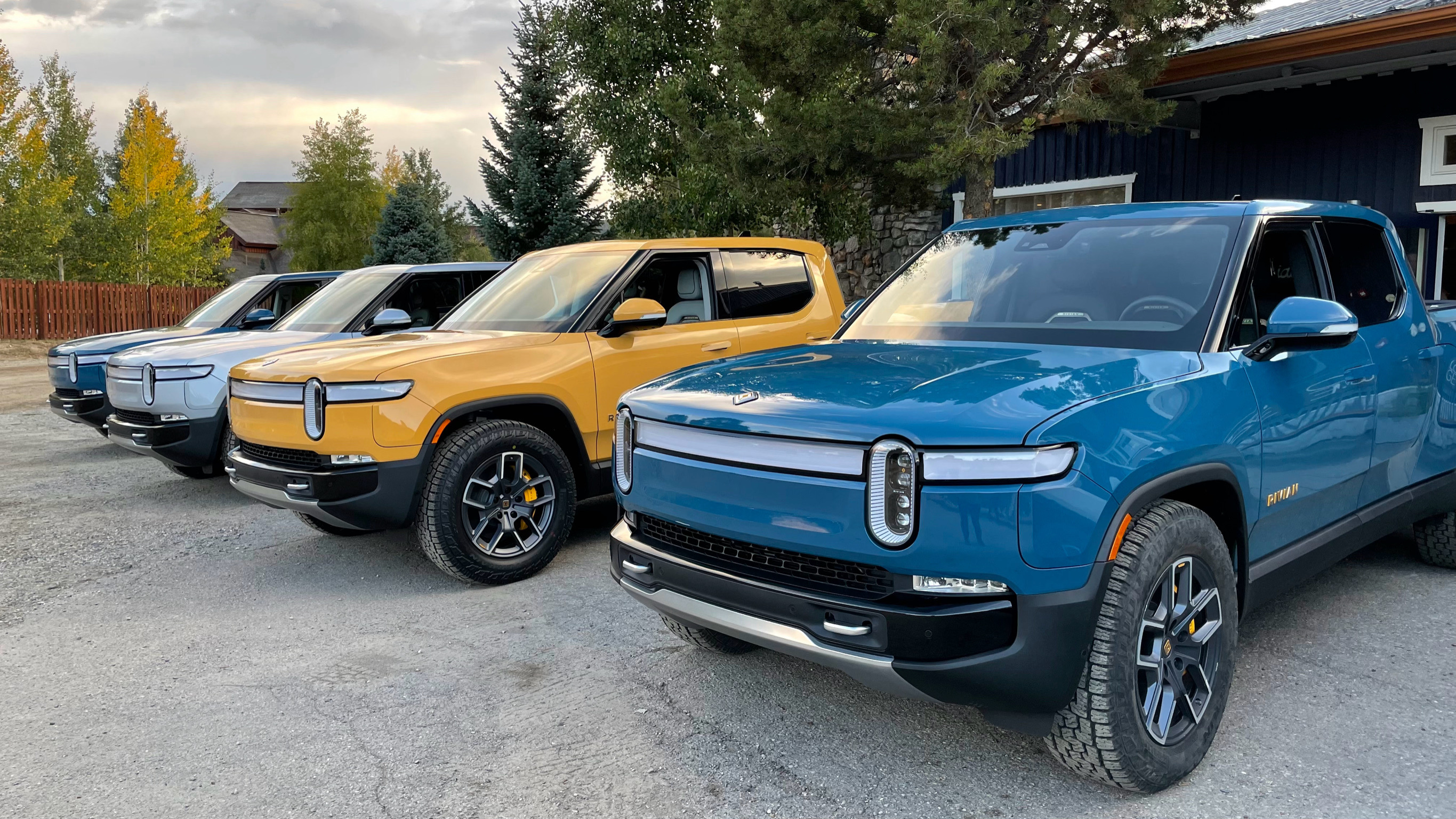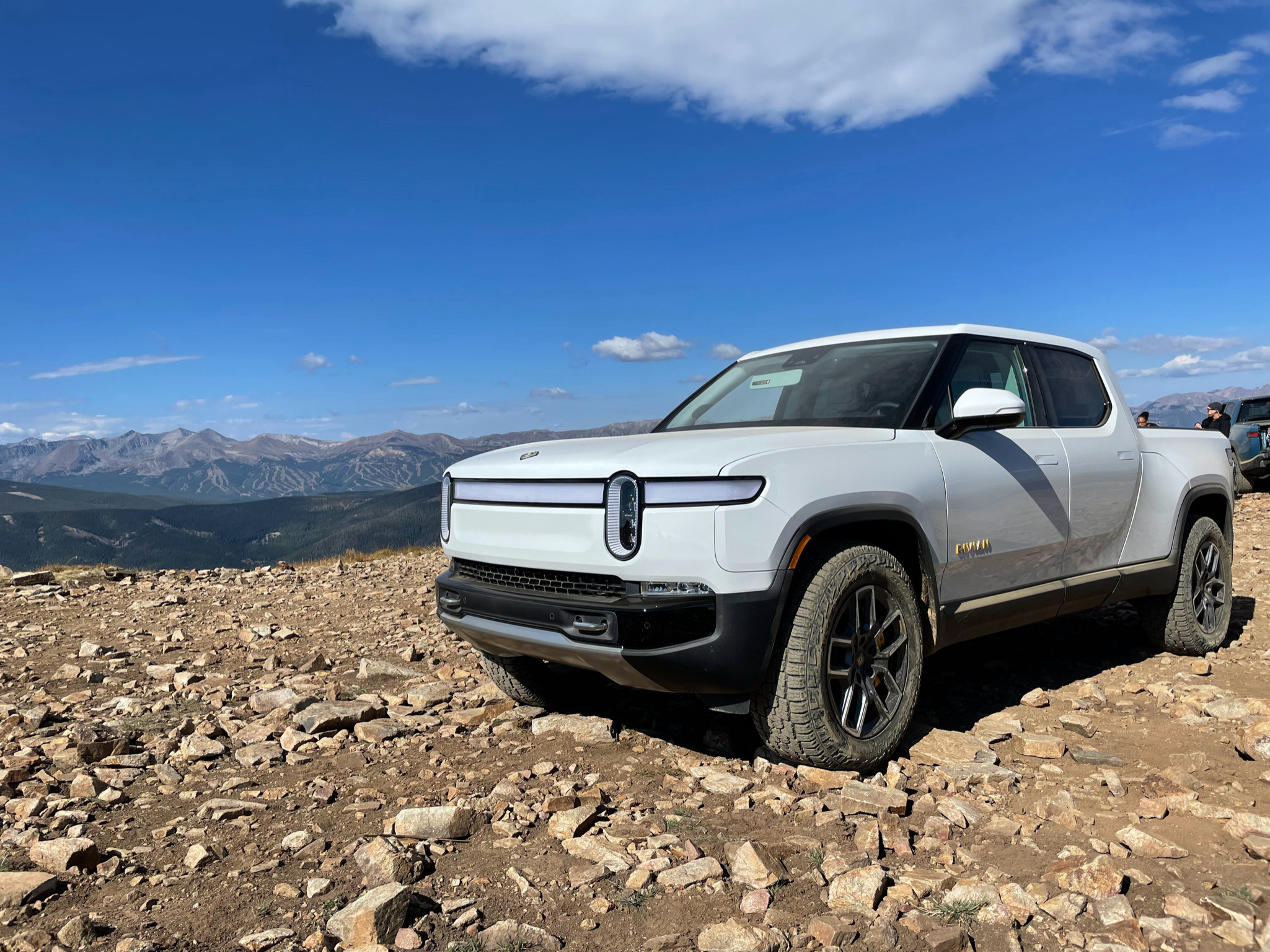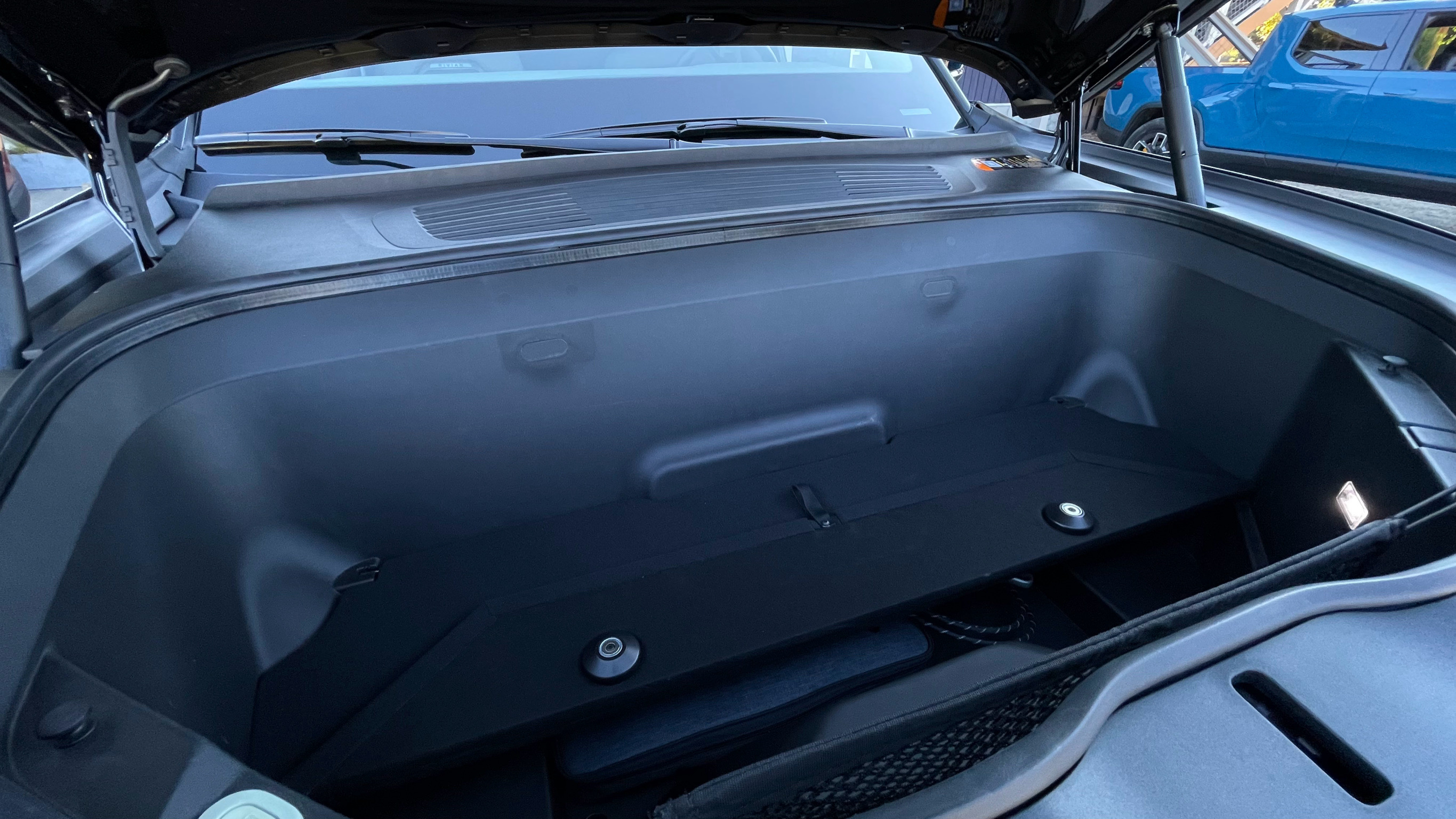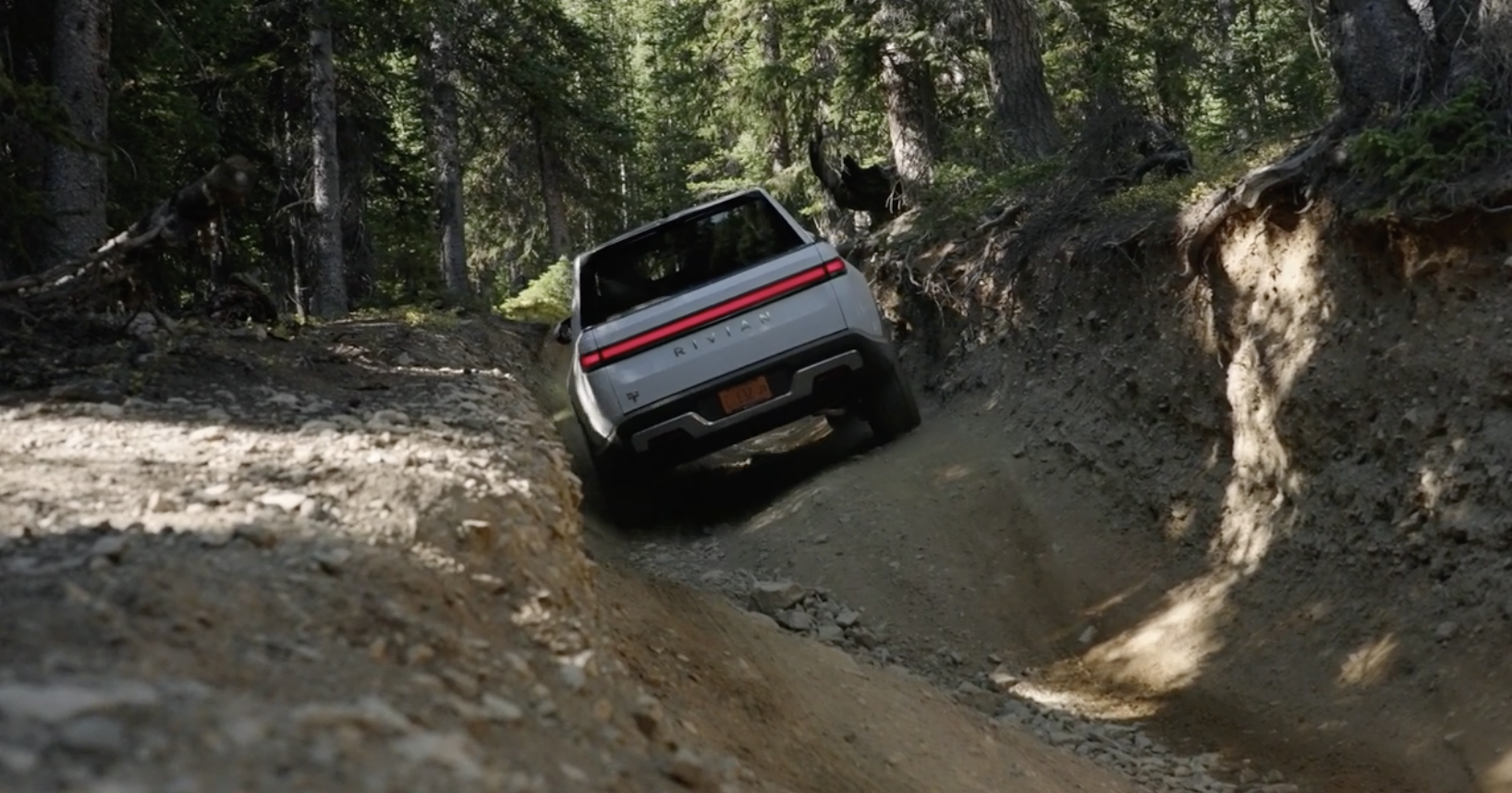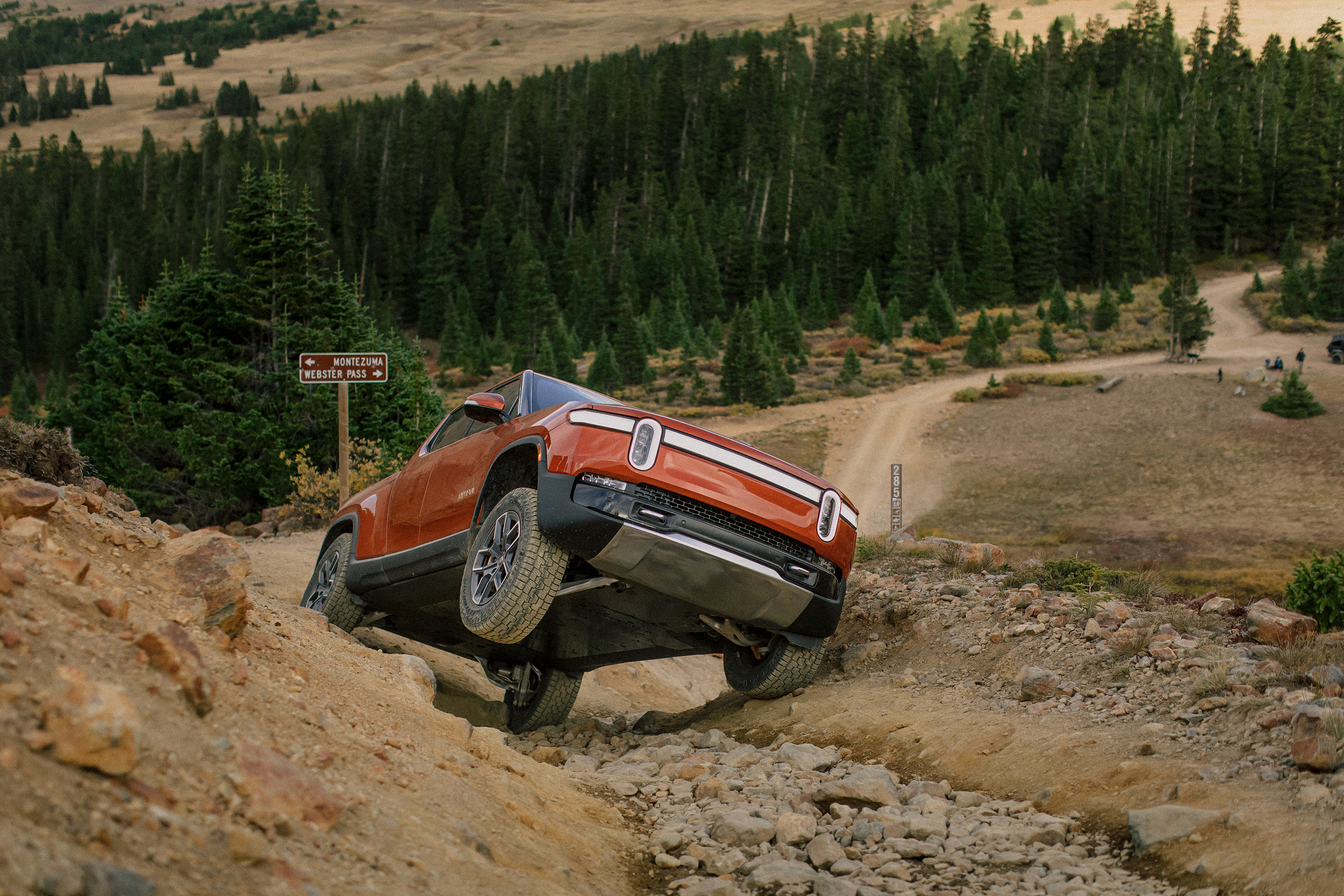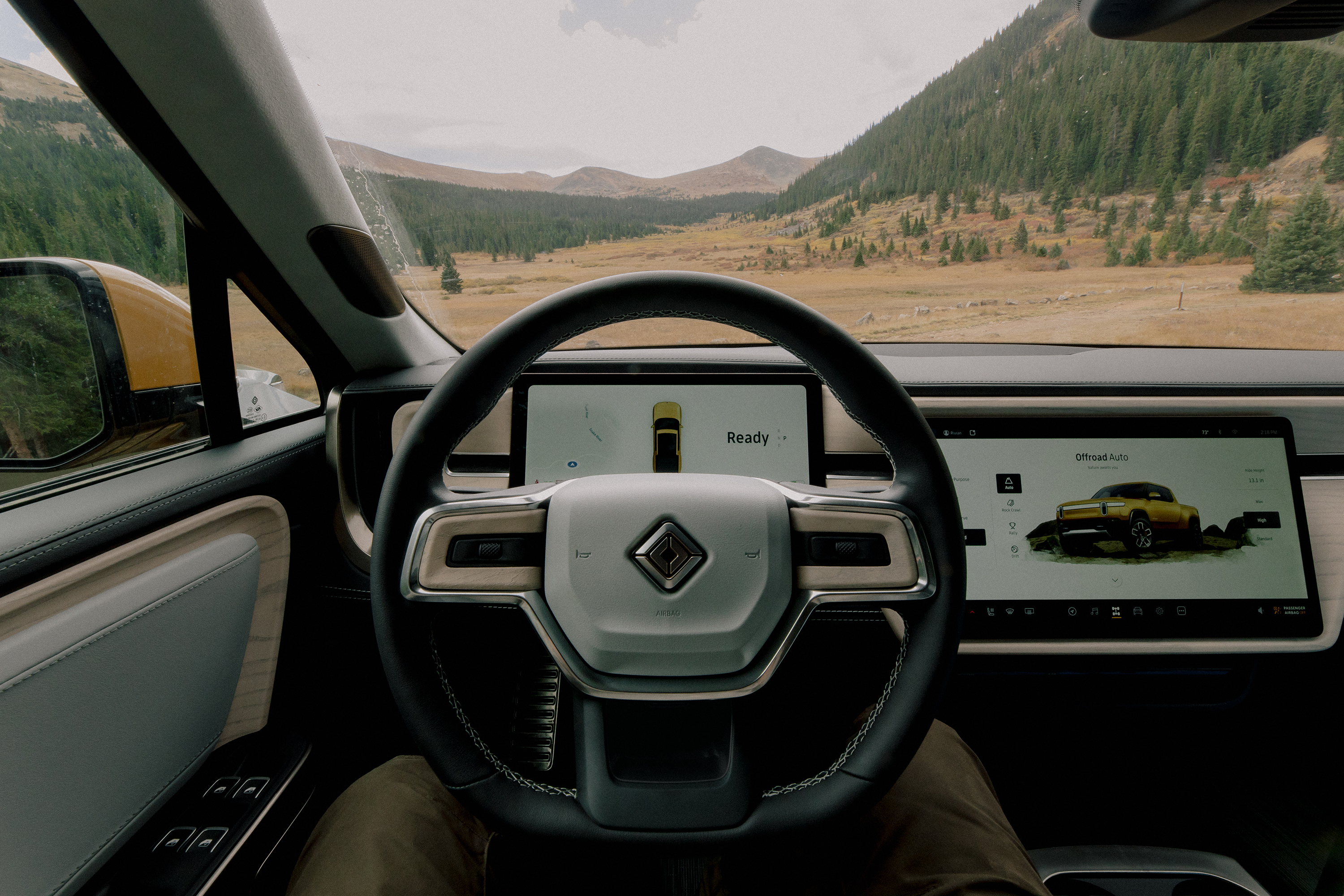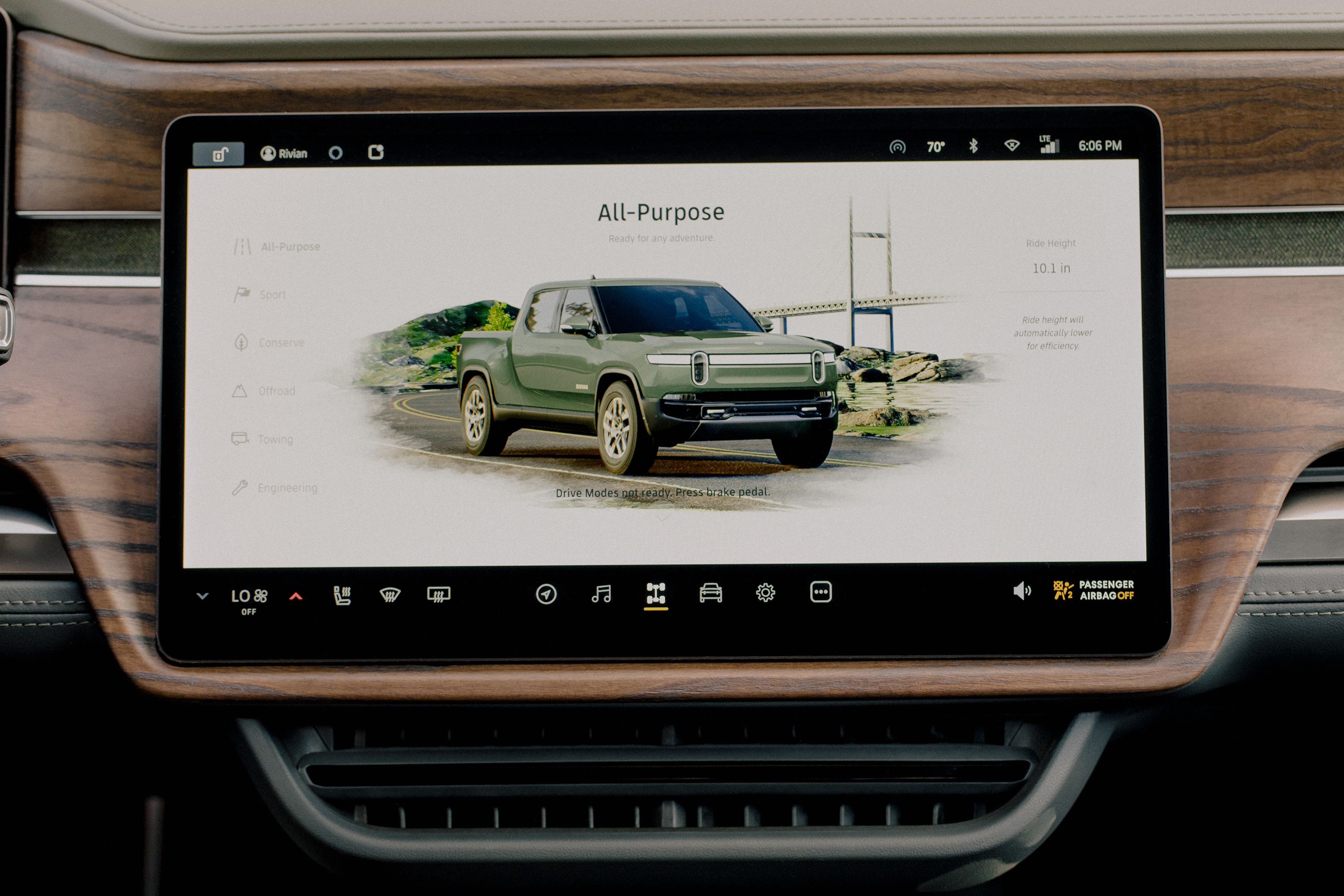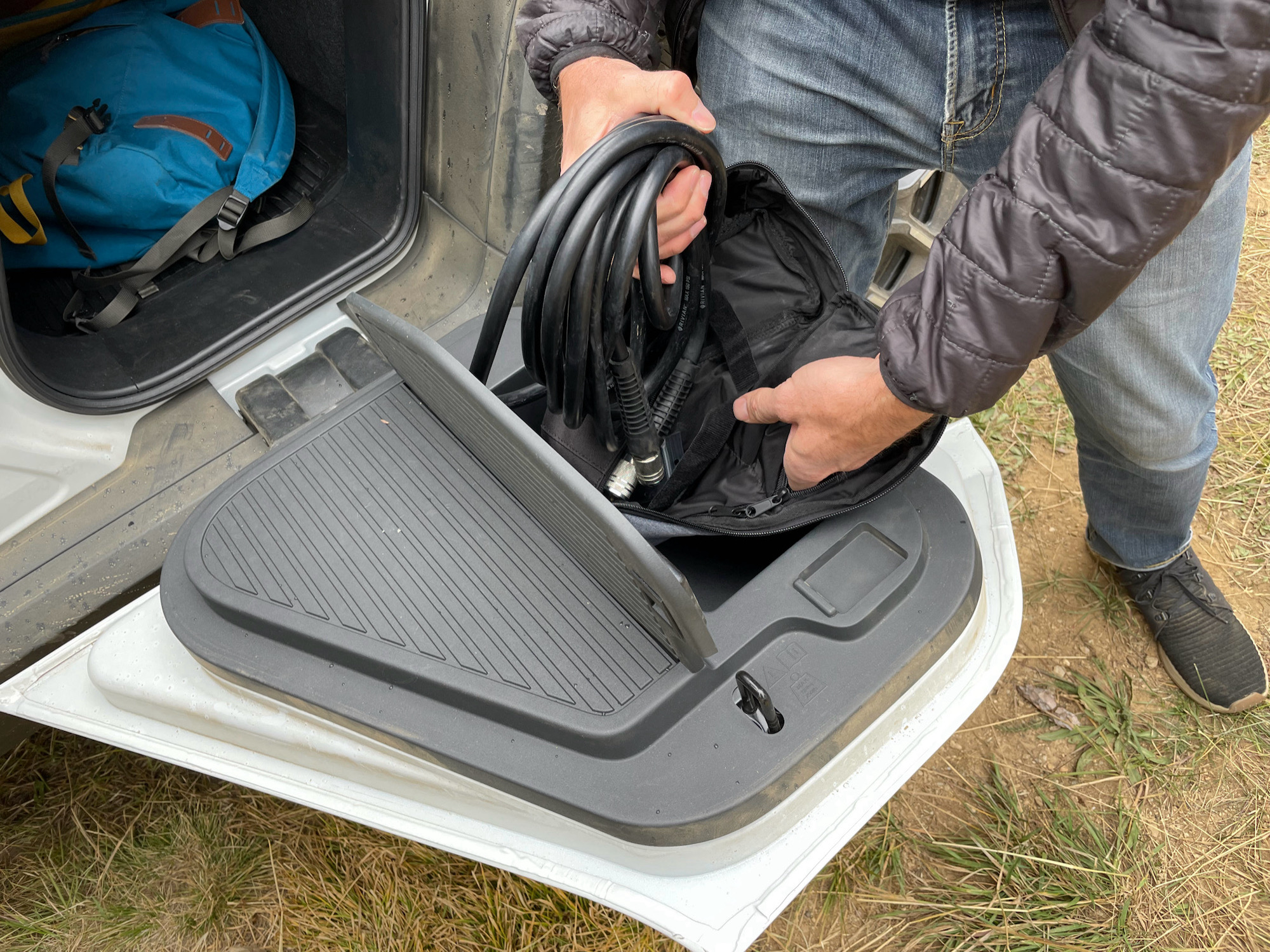On its first try, Rivian produced the Goldilocks of pickup trucks.
The Rivian R1T electric truck is neither too big nor small. It handles rock crawling and off-camber trails with ease, can zip from zero to 60 miles per hour on a dirt road in just a few seconds without the typical back-end slippage — although there is an option to provide that drifting effect — and it can crank through winding mountain roads, pushing the edge of each corner without body roll.
It’s loaded with the kind of interior and exterior touches that put it firmly in the premium zone — and yet the Rivian R1T is no delicate flower.
The company’s designers and engineers helped the truck steer clear of pretension by combining form and function from tip to tail. Some of the added surprises — the location of functional details like tie-downs, a compressor and outlets — suggest that numerous Rivian employees tested the truck in real-world conditions, including camping, mountain biking and even more mundane tasks like grocery-fetching.
The result is a vehicle that feels right for all seasons and ready for anything. And, importantly, it’s a joy to drive.
On a press drive over three days, a near-production-spec R1T proved to be the electric truck none of us knew we needed.
That’s not to say every choice landed perfectly. There are a few hardware details and elements on the software user interface side of things that could use a nip here and a tuck there. I’m looking at you, odd notch that is maybe a pen holder, but certainly the soon-to-be dust collector by the wireless charging pad.
To be clear, far more time and miles are required to provide a full review. Still, as a total package, the Rivian R1T impresses.
What Rivian has accomplished with the R1T is no small feat.
It’s difficult for established automakers to anticipate and then tick every box on consumers’ wish lists. It’s even harder to mass-produce that vehicle all while maintaining proper fit and finish. Rivian is in the rarefied position of aiming to bring the first electric truck to market in the U.S., making it a vehicle that drivers will covet and doing it to scale.
Rivian has delivered on the desirability and drivability fronts. Now it faces two more tests: production and delivery.
It’s making progress toward those goals. The first production Rivian R1T electric pickup truck in “Rivian blue” rolled off the assembly line earlier this month at the company’s factory in Normal, Illinois, marking a milestone more than a decade in the making for the automaker and its founder and CEO, RJ Scaringe.
The company, which started in 2009 as Mainstream Motors before adopting the Rivian name two years later, has undergone explosive growth in terms of people, backers and partners in the past few years.
Rivian operated in secret for years before it revealed prototypes of its all-electric R1T truck and R1S SUV at the LA Auto Show in late 2018.
Since then, Rivian has raised billions of dollars ($10.5 billion since 2019); expanded its Normal, Illinois, factory; hired thousands of employees (more than 8,000); landed Amazon as a commercial customer; and, most recently, filed confidentially for an IPO. In addition to its Illinois factory, Rivian has facilities in Palo Alto and Irvine, California; and Plymouth, Michigan; and an office in the U.K.
Nuts and bolts
The R1T that I drove was a Launch Edition version in glacier white and equipped with Pirelli Scorpion 20-inch all-terrain tires, putting it at about $75,000, excluding the $1,075 destination charge.
The Launch Edition, which comes with special badging, is no longer available. However, Rivian’s “Adventure package” trim, which starts at $73,000, is nearly identical in terms of offerings. The Launch and Adventure editions, for instance, come standard with an off-road upgrade with reinforced underbody shield, dual front bumper tow hooks and air compressor, as well as interior accents, 100% recycled microfiber headliner and “Chilewich floor mats.”
The R1T features a skateboard architecture that houses the battery pack, drive units, an independent air suspension that would prove handy, and thermal and lower body structure. This skateboard chassis integrated all of these pieces together, which means different top hats — or vehicle bodies — can be placed on top. This gives Rivian the flexibility and hopefully cost efficiency to make numerous vehicles using the same foundation.
The result, in this case, is a truck with a low center of gravity and 68 cubic feet of cargo space, which the designers and engineers provide in thoughtful ways that consider customers of all heights. (The two-layered frunk, or front trunk pictured below, being one such example.)
The powertrain includes a 135-kWh lithium-ion battery, four motors for all-wheel drive, and a single-speed transmission that produces 835 horsepower and 908 pound-feet of torque. That’s a lot of numbers that loosely translate to power, performance, and the added benefit of a planted feeling even while accelerating through turns.
How Rivian architected the quad-motor drive — in which a dual-motor drive unit is on the front and rear axles —is worth noting here since I was able to experience why its design matters. The four motors independently adjust torque, which provides traction control in a variety of conditions. in my case, it was dirt roads. This setup also sends power to the wheels that need it most, depending on the situation, which manages slip and helps control vehicle rotation.
The vehicle’s thermal control and battery management system allows for the vehicle to tow up to 11,000 pounds and a DC fast charge rate of 140 miles in 20 minutes at 200 kilowatts— neither of which we were able to try. Those two items are on my list once I get the vehicle to myself for a few days.
The circuit
The press drive started for everyone — except me due to a late plane arrival — at the Denver International Airport. From here, reporters drove about 100 miles along Interstate 70 up and into the Front Range of the Rocky Mountains. The drive would end in Breckenridge, a popular ski town that sits at the base of the Ten-Mile Range. (TechCrunch, not Rivian, paid for my travel and accommodations. Rivian supplied the truck and meals.)
My time in the Rivian R1T would have to wait until the following day.
Early the next morning, and after an outdoor breakfast served on the Rivian camp kitchen, a safety check and briefing, we set off for the main event.
Most of the day would be spent off-road, although I would double-dip into the paved mountain highway driving portion. The initial route, which traveled along the North Fork of the Swan River before connecting to Deer Creek and Saints John (yes, Saints) trails, offered a circuit of rock crawling, a challenging V notch section and some steep uphills and downhills, and a few sections of speed-friendly dirt road that allowed us to try “rally” mode. (More on that later.)
Drivers would eventually pass through the old mining camp-turned-town of Montezuma and then onto Highway 6, a curvaceous stretch of paved road that travels up and over Loveland Pass. The final part of the day varied in mileage depending on the driver. The afternoon route that I and the other reporter in the truck opted for took us up and over Loveland Pass twice and then back through Keystone, onto Swan Road and to our final destination.
The following morning, reporters again had a chance to drive back to the airport. In all, the first drive encompassed about 270 miles over three days.
The handling and performance
During the off-road section, the independent air suspension proved its worth. Drivers can pick from one of several modes: all-purpose, sport, off-road, conserve and towing. Within the off-road mode, there are even more options, including off-road auto, rock crawl and rally. There’s also a drift mode, which I didn’t test.
The ride height, damping, pedal map that controls regenerative braking, and suspension on the vehicle adjust depending on the drive mode. For instance, in conserve mode, the vehicle lowers to about 8 inches; in off-road, it can be as high as 14.9 inches.
During our off-road excursion, we put the vehicle up and over steep slopes and even made a shallow ford. The ground clearance, combined with an approach angle of 34 degrees, a breakover of 25.7 and departure angle of 29.3 degrees, meant the vehicle never scrapped or stuttered. There were moments when, as I prepared to drive around a particularly large boulder — the standard technique in other vehicles — a Rivian employee would encourage me to just drive over it. And I would, without the negative results.
The only issue that cropped up during our day of off-road driving was the passenger window, which would occasionally lag or stop. While that would be problematic in production-spec’d vehicle, I suspect, and would hope, that these are the kind of minor glitches found and fixed in the weeks leading up to customer deliveries.
While the performance of the vehicle in these various modes proved worthy, the interface made moving between them a little wonky. More on that next.
User interfaces
The interior of the vehicle provides a mostly good balance of technology and physical components. The windshield wipers and gear selector are on stalks, and thankfully not located in the central infotainment system. And there are two thumb toggles on the steering wheel for controlling volume, skipping tracks and controlling the phone and Alexa voice assistant, as well as some of the advanced driver assistance features.
There is also a driver monitoring system (camera) that is meant to be used when the advanced driver assistance system, branded Driver+, is activated. And there is a driver display, which is simple in its design and delivers only a few pieces of critical information, including speed, a navigation map, if needed, and range.
Moving to the right and center is a rectangular central touchscreen that houses nearly everything needed for the vehicle, including a few items that I wish had a redundant physical button or knob. First, a positive note: the infotainment system skips the dreaded home screen button and instead places all of the necessary items permanently on the bottom. This makes finding and navigating to almost everything intuitive.
You won’t find me whining for more buttons and knobs on a typical day. But when headed up a steep rocky slope, I audibly wished for the ability to move the direction of the air vent without tapping the touchscreen and moving the small dot until the air moved away from my face. Nor did I love trying to change the brake regen levels while bumping along the trail or driving along winding mountain roads.
Some of that awkwardness would likely be erased after more time in the truck. Still, there are specific spots — the HVAC being the big one — where I suspect the Rivian customer will want the option to grab a physical knob or vent.
The software in my truck operated as it should, meaning in this test truck we didn’t experience any lagginess. My phone connected easily via Bluetooth and was able to play music. Notably, the vehicle is not equipped with Apple CarPlay or Android Auto.
Rivian does have the benefit of being software-centric and has a cloud-based architecture that will allow for over-the-air software updates that employees promise me won’t require a trip to a service center. Instead, these updates will occur with some regularity and deliver new features and apps.
Tesla owners have come to love the OTAs because the company has used them as a means to deliver video games and other fun surprises. The Rivian seems, at least for now, to lean less on this. The “Easter eggs” in the vehicle were hardware-focused, which might be based on what Rivian believes its future customers want.
Hardware accessories
There are a few hardware components such as the keys, gear tunnel and gear guard that are worth mentioning at least briefly. I’ll be digging into all of the accessories, including the nifty portable speaker, tire compressor and flashlight, in future articles this week.
First up is the key. Or perhaps keys. Rivian developed four ways for owners to get into their vehicles: the phone app, a fob that has a carabiner-type lock, a credit card-like key and a bracelet. That might seem like overkill, but it is in keeping with the Rivian customer, who is active and likely on some kind of adventure in a remote area.
Next up is the Rivian gear tunnel, which provides 11.6 cubic feet. This is the central feature of the vehicle and the one design element that Scaringe told me remained consistent through numerous iterations of the truck’s early designs.
Inside the gear tunnel is an optional skateboard upgrade, which the $5,000 camp kitchen can attach to. But clearly, Rivian is preparing for more accessories — maybe a heater for ski and snowboard boots or a snap-on bucket for storing dirty biking clothes (I’m just making suggestions) — that can be attached to the skateboard.
The gear tunnel doors, which pop up once the user pushes a button on the pickup bed frame, drop down. The doors, which are robust enough for a person to stand on, provide more storage. In the photo below, a Rivian employee can be seen removing the compressor attachment from one of the compartments.
Finally, there is a hardware and accompanying software feature called Gear Guard, which is included in the Adventure package trim. The system consists of a locking cable that is plugged into the truck bed wall and then can be connected to a bike mounted on the rack or other gear. Once connected, the security system kicks in, as you can see in the photo below.
The security system taps into the vehicle’s 10 exterior cameras and will record a person if they approach and begin to tamper with the gear. That recorded video and be viewed on the central display, stored and even shared. The missing detail is that this is not delivered immediately to the user’s phone app.
I expect that Rivian will add that functionality as it rolls out and improves its app.
And that’s the beauty of building a vehicle from the ground up while focused on the integration of software and hardware: Many of these niggling details can be improved.
What Rivian got right just happens to be the stuff that would be the hardest to change. The truck has the off-road capability of a truck, the on-road performance of a zippy sedan or sports car, and the added benefit of quiet electric power, all without skimping on design, interior material choices, software or functional accessories.
It’s the kind of inaugural effort that should build confidence in the brand. And I suspect will hit the right note with customers.

